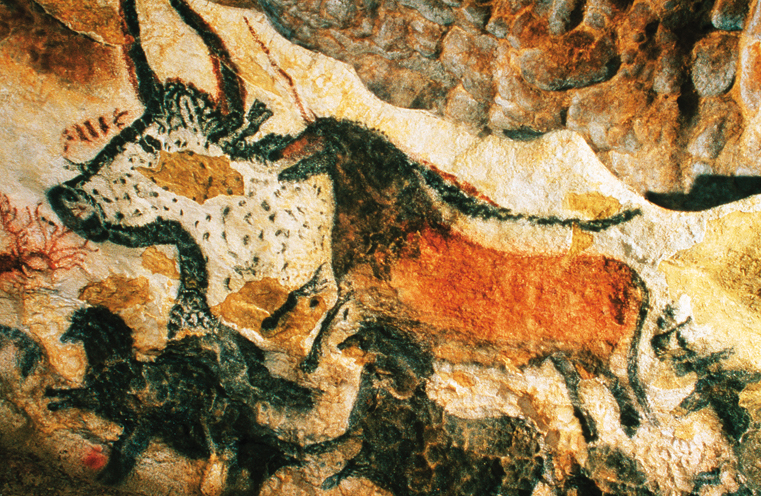A History of World Societies:
Printed Page 12
A History of World Societies Value
Edition: Printed Page 13
Cultural Creations and Spirituality

Early human societies are often described in terms of their tools, but this misses a large part of the story. Beginning in the Paleolithic, human beings have expressed themselves through what we would now term the arts or culture: painting and decorating walls and objects, making music with their voices and a variety of instruments, imagining and telling stories, dancing alone or in groups. Evidence from the Paleolithic, particularly from after about 50,000 years ago, includes flutes, carvings, jewelry, and paintings done on cave walls and rock outcroppings that depict animals, people, and symbols. In many places these paintings show the outline of a human hand — often done by blowing pigment around it — or tracings of the fingers, a simple art form that allowed individuals to say “I was here.” (See “Viewpoints 1.1: Paleolithic Hand Markings.”)
Some cultural creations appear to have had a larger purpose: they may have been created to honor and praise ancestors or leaders, help people remember events and traditions, or promote good hunting or safe childbirth. Some were easy to do, and everyone in a culture was expected to participate in some way: to dance in order to bring rain or give thanks, to listen when stories were told, to take part in ceremonies. Other creations required particular talents or training and were probably undertaken only by specialists.
At the same time that people marked and depicted the world around them, they also appear to have developed ideas about supernatural forces that controlled some aspects of the natural world and the place of humans in it, what we now term spirituality or religion. The Neanderthals’ careful burial of their dead suggests to some scholars that they had ideas about an afterlife or at least something beyond the visible world, and there is no doubt that this was the case for Paleolithic Homo sapiens. Paleolithic burials, paintings, and objects suggest that people may have thought of their world as extending beyond the visible. People, animals, plants, natural occurrences, and other things around them had spirits, an idea called animism. The only evidence of Paleolithic animism that survives is physical, of course, but more recent animist traditions carry on this understanding of the spiritual nature and interdependence of all things, as in this contemporary Chinook blessing from northwestern North America:
We call upon the Earth, our planet home, with its beautiful depths and soaring heights, its vitality and abundance of life, and together we ask that it Teach us, and show us the Way. . . .
We call upon the creatures of the fields and the forests and the seas, our brothers and sisters the wolves and the deer, the eagle and dove, the great whales and the dolphin, the beautiful orca and salmon who share our Northwest home, and ask them to Teach Us and show us the Way.1
Death took people from the realm of the living, but for Paleolithic groups people continued to inhabit an unseen world, along with spirits and deities, after death; thus kin groups included deceased as well as living members of a family. The unseen world regularly intervened in the visible world, for good and ill, and the actions of dead ancestors, spirits, and gods could be shaped by living people. Concepts of the supernatural pervaded all aspects of life; hunting, birth, death, and natural occurrences such as eclipses, comets, and rainbows all had religious meaning. Supernatural forces were understood to determine the basic rules for human existence, and upsetting these rules could lead to chaos.
Ordinary people learned about the unseen world through dreams and portents, and messages and revelations were also sent more regularly to shamans, spiritually adept men and women who communicated with the unseen world. Shamans created complex rituals through which they sought to ensure the health and prosperity of an individual, family, or group. Many cave paintings show herds of prey animals, and several include a masked human figure usually judged to be a shaman performing some sort of ritual. Objects understood to have special power, such as carvings or masks in the form of an animal or person, could give additional protection, as could certain plants or mixtures eaten, sniffed, or rubbed on the skin. Shamans thus also operated as healers, with cures that included what we would term natural medicines and religious healing.

Judging by practices from later periods, the rituals and medicines through which shamans and healers operated were often closely guarded secrets, but they were passed orally from one spiritually adept individual to another, so that gradually a body of knowledge developed around the medicinal properties of local plants and other natural materials. By observing natural phenomena and testing materials for their usable qualities, Paleolithic people began to invent what would later be called science.